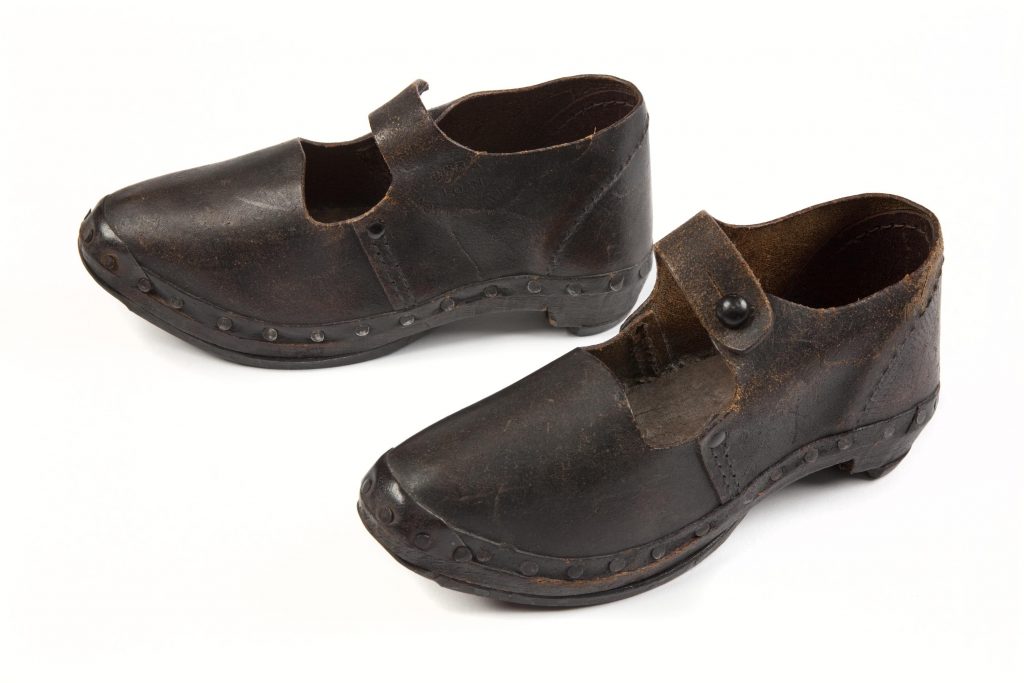The gallery will paint a vivid picture of how cotton transformed Manchester into a city like nothing the world had ever seen before, populated by ingenious makers and determined profit seekers, spinning and weaving cloth to sell around the globe. In this sprawling, swarming, rain-soaked city of extreme wealth and poverty, the cotton industry reshaped the lives of Manchester people, creating a new kind of urban community.
Among the new objects on display are a pair of child sized clogs from Charter Street Ragged School. These clogs were lent to children too poor to afford their own shoes—but had to be stamped with instructions not to be pawned, as poverty meant that families would consider swapping their borrowed shoes for a hot meal. There are also coins that were hidden in the roof of a cotton mill during construction as a lucky charm to bring prosperity, a 180-year old cotton day dress made at the peak of Manchester’s industrial transformation and updated displays that explain the links between Manchester’s textiles industry and the transatlantic slave trade.
Much-loved objects from the gallery’s current form, such as Richard Arkwright’s incredible Water Frame that revolutionised cotton production, will be redisplayed in a way that will increase visitors’ enjoyment, and the ever-popular Explainer shows among the working mill machinery have been updated to give an even deeper and more exciting insight into the birth of the industrial revolution.

Science Museum Group Collection © The Board of Trustees of the Science Museum
As well as new interactive displays, the gallery will include a conversation space where visitors will be able to try hands-on activities, get up close with unusual objects and have their say in upcoming projects in the gallery.
The museum team have been working with award-winning designers Nissen Richards Studio to create the new look for the gallery.
In order for the work to take place, the gallery will be closed for five days from 21 May, reopening temporarily for half term so visitors can continue to enjoy textiles demonstrations throughout the holidays. Work will commence in earnest on 4 June before the refreshed gallery re-opens at the end of July.
During the temporary closure, weaving workshops and textiles talks will take place in the Revolution Manchester gallery, adjacent to the Textiles Gallery.
The Textiles Gallery is in the museum’s Great Western Warehouse, a Grade II listed building that dates back to 1880, and was one of the original buildings of the goods station site that surrounded Liverpool Road Station, which was in turn the terminus of the world’s first inter-urban passenger railway.
The makeover is part of an ambitious programme of work in the run-up to the unique site’s 200th anniversary in 2030, which will reveal the fascinating stories of the museum site and its role in the development of Manchester and the industrial world.
2 comments on “New look for the Textiles Gallery”
Comments are closed.
I hope there is gonna be some consultation with Black Brits in and around Manchester, especially those whose anscestors were kidnapped and inserted into the cotton industry!
I am astonished there is nothing (in this blog post) that alludes to those Africans that suffered kidnapping, torture, genocide, murder, rape, having their children killed and taken from them for hundreds of years, just to provide labour for this said same cotton industry.
Does the absence mean you aren’t going to include their stories/narrative or just that u need to rewrite this blog post.
It was bad enough being absent in the current space but there is no excuse now.
You need to rethink this.
Hi Abby,
Thanks for your comment – we’ve updated the post to reflect your query. We have worked to address the absence of this story by including updated displays that explain the links between Manchester’s textiles industry and the transatlantic slave trade. However, there is more work to do here, so in the coming years, through research, consultation and partnerships, we aim to look at the collections and our displays in new ways and work to develop how the slave trade is represented in the museum.
The conversation space is designed so that we can work more closely with audiences as we develop upcoming activities and exhibitions and ensure that these ideas are developed collaboratively.
Hope this helps.